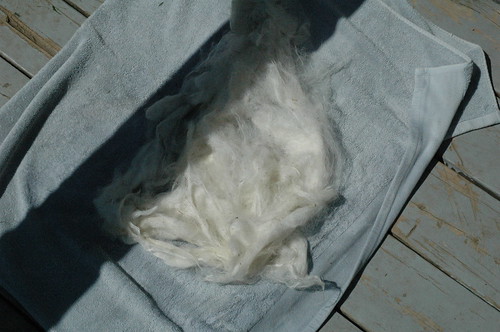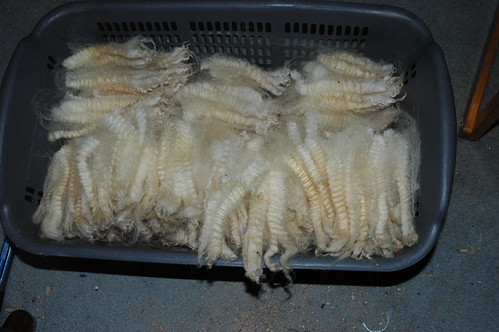Good Morning 🙂

I’ve been working on cleaning the alpaca fleece(s) that I have from last fall, while trying to conserve water and energy at the same time. It’s wonderful to process my own fiber but the point begins to get a little lost if I use too many resources to do it with! My general method, last year, was to take out any burrs and then use a few (usually three) washes with very hot water and as many rinses in hot water as were required to get the fleece very very white. I would then have to comb the locks for debris and vegetable matter, anyway, because there is a lot of that that will not come out in a wash.

I’ve now realized that was overkill. Through experimenting, I’ve found that if I comb out the tips of the locks (really handfuls of locks) VERY well *before* washing, I can save a lot of time, water and electricity! Really, the biggest issue with alpaca is the dust and vm. If you can eliminate a great deal of that before washing you will be able to use the wash water for longer and wash each ‘bundle’ of alpaca fewer times. Less vm also means less rinsing and less rinse water used. Lower temps mean eliminating the necessity of boiling water, to begin with. I DO boil water to bring the wash temperature back up if it is losing heat quickly outside.
This is the ‘comb’ I use to comb out the upper section of each lock. I like to hold the locks by the cut end and keep that together, ideally. It helps later to be able to see the seperate locks. It’s actually a dog rake – you can find it in any pet store.

The set up – I have two bins, one for washing, one for rinsing. Both are large storage bins which are very common. I have two wire waste baskets from the dollar store which work wonderfully as fleece baskets for washing, rinsing and ‘fishing’ out the clean fleece from the water. Then there is the soap – original blue dawn dish detergent, the kind WITHOUT enzymes. You don’t want enzymes as, if any at all is left in the wool, they will eat the fiber over time. Nothing sadder than going back to a clean fleece and finding it weak and deteriorated. I’ve not experienced this myself but have heard it can happen. I keep a couple wooden spoons to manipulate the fleece in the water and also a towel to roll and squeeze the water out of the washed and rinsed fleece bundles. My sweater drying racks work excellently as fleece drying racks.

So, I start with a handful of unwashed fleece – just pulling off some at the edge of the blanket, enough to fill my hand and work with comfortably.

An example of what most of the fleece looks like (what you see on top is the nicest part!)

The dog rake works best if I loosen the tips first and then comb out the lock from the centre to the tip – a lot like dealing with badly tangled hair, you don’t want to pull hard enough to break or damage fiber, or hard enough to badly mangle the lock – just work slowly and be gentle.

The really messy lock I showed above, once combed…Wearing old clothes is a great idea because you WILL be covered in dust and dirt and vegetable matter. A surprising amount comes out with just this combing.

Once I’ve combed out enough to work with without rushing through the process to keep up with myself, I fill the wash bin with hot tap water and then add a generous bit of Dawn dishsoap.

I have heard that alpaca felts but have not had any problems with that at all. I totally swish it around, push it back under the water as needed. I’m always much more careful with wool. Because I haven’t had trouble with felting, I now put the fleece in by itself instead of using the wire baskets to hold it (a la mesh to keep locks in order).

I’ve found that a 25 minute soak is a very good amount of time, with a few swishes. I am able to use the one tub of water for three or four batches of fleece. The rinse bin is smaller (but doesn’t need to be, that’s what I had) and I rinse for a few minutes, maybe ten, in hot water.
As you can see, the alpaca is very clean and has only had the combing, one wash and this (first and only) rinse.
I pull it all out of the rinse water and roll it in a towel. The towel hangs on the line in between uses and that way can be reused all day long (if I want to clean fleece all day long).


I end up with this lovely cloud of fiber – really a collection of locks which are still easy to locate and work with. One strange thing (I’m always amazed) is how nicely the flattened out, wet fiber fluffs right back up again with drying.

By the end of the day, I had a large bin of clean alpaca…


And still this much left in the to-be-washed bin…

It’s seemingly endless 🙂

































